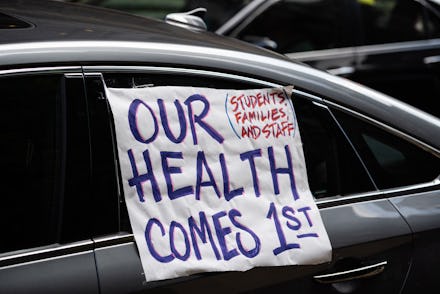A Missouri teacher died from coronavirus, underscoring the life-or-death stakes this school year

As the country enters its seventh month of the coronavirus pandemic, the failures of state-level education policies and paltry school budgets are combining into the worst possible scenario for reopening schools. In Missouri, a 34-year-old special education teacher has died of coronavirus complications after three weeks of hospitalization. Though the teacher was hospitalized before students in the district returned to their classrooms on Aug. 24, her death is a stark reminder of what teachers are risking when they return to their jobs.
Around the country, teachers are literally fighting for their lives against the expectation that schools return to "normal" during a still-very-much-ongoing pandemic. In Arizona, a teacher decided not to return for face-to-face instruction and was subsequently fined $2,000 by his school district for retiring before his contract allowed. "My thinking was, we are in a global pandemic where people are losing their lives left and right," the teacher said. "The protocols you've set in place will not keep me from getting [COVID-19] and bringing it home to my family, so why do I have to pay you $2,000, when you haven't paid me anything?" In other states, like Kansas, that fine can reach up to $10,000; the average teacher salary in the state is around $54,000.
The comment points to another difficulty that teachers are facing in these times: They're effectively front-line workers, yet they're treated and paid as if they're easily replaceable. When teachers go on strike, as they have in Illinois, Arizona, and Massachusetts, they risk their jobs and salaries and may face legal action, all to demand better conditions. And their concerns, as they relate to reopening processes, are sometimes treated as surface-level complaints rather than fact-based predictions of what will happen without adequate preparation, supplies, and personal protective equipment.
In New Jersey, some school districts have proposed a hybrid learning model that teachers say is both ineffective and dangerous. As one local news site reported, "In-person learning is limited to half-days in the morning, with students split into two different groups. The groups will attend school on alternating weeks, and everyone will learn remotely in the afternoon." The varying schedules mean that teachers have to prepare for different lessons based on instruction format, and that the time spent readying students for online learning limits the actual instruction time. Moreover, adapting to new demands, like making sure windows remain open to circulate air, means that "safety procedures have gone out the window at this point," one teacher said.
As the tragic death in Missouri makes clear, the stakes of reopening schools could not be higher, yet few districts are truly prepared to meet the needs of teachers and students. Many schools, from elementary all the way to college level, have already shuttered after attempting to resume in-person learning.
Yet teachers, for the most part, still want to teach and reconnect with their students after a traumatic summer. "It’s not that teachers are lining up to resign," one Kansas teacher said. "They want to teach. But they just want to have that choice to do it safely."